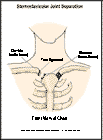
Sternoclavicular Joint Separation
What is a sternoclavicular joint separation?
The sternoclavicular joint is located where the collarbone (clavicle) attaches to the breastbone (sternum). These bones are held together by a piece of connective tissue called a ligament. A sternoclavicular separation occurs when the ligament tears.
How does it occur?
A sternoclavicular joint separation most commonly occurs when there is a direct blow to the sternum or a fall onto the shoulder or outstretched hands that causes a force along the length of the collarbone. It may occur in a contact sport when a player's shoulder hits the ground and another player lands on top of the other shoulder.
What are the symptoms?
There is pain, swelling, and tenderness over the sternoclavicular joint. There may be movement between the breastbone and the collarbone. Your collarbone may be displaced either in front of your breastbone or behind your breastbone.
How is it diagnosed?
Your health care provider will review your symptoms and examine your sternoclavicular joint. An x-ray or CT (computed tomography) scan may be ordered to see if there is a gap between your collarbone and breastbone.
How is it treated?
Treatment may include:
- putting ice packs on the injury for 20 to 30 minutes every 3 to 4 hours for 2 to 3 days or until the pain goes away
- taking anti-inflammatory medication or pain medications prescribed by your health care provider
- wearing a sling
- resting your shoulder and arm on the side of the separation until the pain goes away.
In cases where the collarbone is forced behind the breastbone, there may be a risk of damage to the heart or the blood vessels in the chest and surgery may be required to repair the separation.
In some cases, the sternoclavicular joint heals but may have some instability, or movement, when you move your arm or shoulder. If this instability causes pain, your health care provider may recommend surgery.
When can I return to my sport or activity?
The goal of rehabilitation is to return you to your sport or activity as soon as is safely possible. If you return too soon you may worsen your injury, which could lead to permanent damage. Everyone recovers from injury at a different rate. Return to your sport or activity will be determined by how soon the injured area recovers, not by how many days or weeks it has been since your injury occurred.
You may safely return to your sport or activity when:
- You no longer have pain at the sternoclavicular joint.
- You have full range of motion and strength of your shoulder.
How can I prevent a sternoclavicular joint separation?
A sternoclavicular joint separation is usually caused by an accident that cannot be prevented.

